
Sir Geoffrey Charles Hurst is an English former professional footballer. A striker, he became the first player to score a hat-trick in a World Cup final, as England recorded a 4–2 victory over West Germany at Wembley in 1966. With the death of Sir Bobby Charlton in October 2023, Hurst became the last living player from the team that won the 1966 final.

The 1966 FIFA World Cup final was a football match played at Wembley Stadium in London on 30 July 1966 to determine the winner of the 1966 FIFA World Cup, the eighth FIFA World Cup. The match was contested by England and West Germany, with England winning 4–2 after extra time to claim the Jules Rimet Trophy. It was the first – and to date only – occasion that England has hosted or won the World Cup.
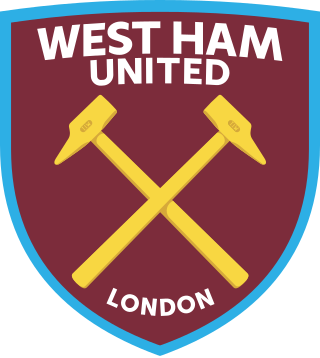
West Ham United Football Club is a professional football club based in Stratford, East London, England. The club competes in the Premier League, the top tier of English football. The club plays at the London Stadium, having moved from their former home, the Boleyn Ground, in 2016.
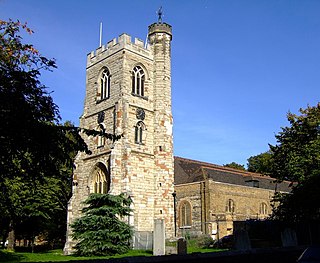
West Ham is a district in East London, England and is in the London Borough of Newham. It is an inner-city suburb located 6.1 mi (9.8 km) east of Charing Cross.
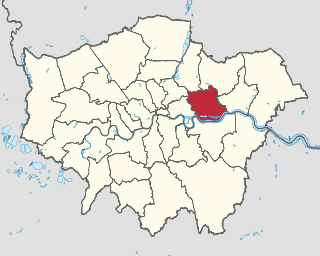
The London Borough of Newham is a London borough created in 1965 by the London Government Act 1963. It covers an area previously administered by the Essex county boroughs of West Ham and East Ham, authorities that were both abolished by the same act. The name Newham reflects its creation and combines the compass points of the old borough names. Situated in the Inner London part of East London, Newham has a population of 387,576, which is the fourth highest of the London boroughs and also makes it the 26th most populous district in England. The local authority is Newham London Borough Council.
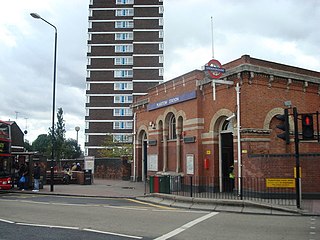
Plaistow is a inner city area of East London, England, within the London Borough of Newham. It adjoins Upton Park to the north, East Ham to the east, Beckton to the south, Canning Town to the south-west and West Ham to the west.

East Ham is a district of the London Borough of Newham, England, 8 miles (12.8 km) east of Charing Cross. Within the boundaries of the historic county of Essex, East Ham is identified in the London Plan as a Major Centre. The population is 76,186.

Martin Stanford Peters was an English footballer and manager. As a member of the England team which won the 1966 FIFA World Cup, he scored the second of England's four goals in the final against West Germany. He also played in the 1970 FIFA World Cup. Born in Plaistow, Essex, he played club football for West Ham United, Tottenham Hotspur, Norwich City and Sheffield United. He briefly managed Sheffield United before retiring from professional football in 1981.

Sir Trevor David Brooking, is a former England international footballer, manager, pundit and football administrator; he now works as director of football development in England.

Upton Park is an area of the East London borough of Newham, centred on Green Street which is the boundary between West Ham and East Ham. West Ham United Football Club formerly played at the Boleyn Ground, commonly known as Upton Park.

The Boleyn Ground, often referred to as Upton Park, was a football stadium located in Upton Park, East London. It was the home of West Ham United from 1904 to 2016, and was briefly used by Charlton Athletic in the early 1990s during their years of financial difficulty. The seating capacity of the ground at closure was 35,016.
Philip Henry Christopher Jackson CVO DL is a Scottish sculptor, noted for his modern style and emphasis on form. Acting as Royal Sculptor to Queen Elizabeth II, his sculptures appear in numerous UK cities, as well as Argentina and Switzerland.
The Academy of West Ham United F.C. is historically one of the most productive football academies in British football. This success has resulted in its nickname the Academy of Football.
The 1964–65 season of the European Cup Winners' Cup club football tournament was won by West Ham United in a final at Wembley Stadium against 1860 Munich. West Ham's Bobby Moore captained a side that also included Geoff Hurst and Martin Peters just one season before all three went on to star in England's World-Cup-winning side of 1966. As a result of their CWC success, Bobby Moore became the only captain to climb the Wembley steps to be presented with three different trophies in three successive seasons.

Green Street is a road in the London Borough of Newham, East London, which forms much of the boundary between East and West Ham.
The 1965–66 season was the 86th season of competitive football in England.
Upton Park Football Club is an amateur football club from Upton Park, then in Essex but now part of the London Borough of Newham, in the late 19th and early 20th century, now defunct. As well as being one of the fifteen teams that played in the inaugural FA Cup in 1871, they also represented Great Britain at the first ever Olympic football tournament in 1900, which they won.

Robert Frederick Chelsea Moore was an English professional footballer. He captained West Ham United for more than ten years, and was the captain of the England national team that won the 1966 FIFA World Cup. He is widely regarded as one of the greatest defenders in the history of football, and was cited by Pelé as the greatest defender he had ever played against. Moore is sometimes considered to be one of the greatest players of all time.
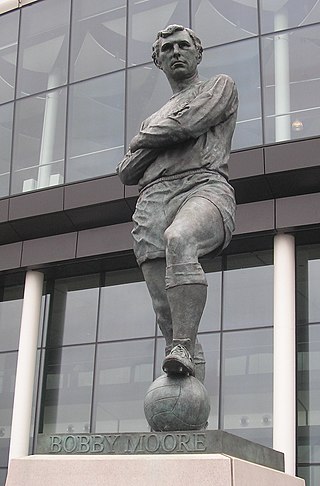
The Bobby Moore statue is a bronze sculpture of the former West Ham and England footballer Bobby Moore, situated directly outside England's national stadium, Wembley Stadium, in Wembley Park, north-west London. It commemorates the life of Moore, who captained the only England side ever to win the World Cup, defeating Germany 4–2 in the 1966 FIFA World Cup Final held in England at the old Wembley Stadium, demolished in 2003. Commissioned by the Football Association, it was unveiled outside the new stadium when it opened in 2007, fourteen years after Moore's death from cancer, aged 51. Standing 20 feet (6.1 m) tall on a stone plinth, it looks out over spectators as they walk down Wembley Way into the stadium. Sculpted by the Royal Sculptor Philip Jackson, it is Jackson's second piece featuring Moore, after the World Cup Sculpture unveiled in 2003.
The Betway Cup is a pre-season friendly competition hosted by Premier League club West Ham United. It is sponsored by betting company Betway, who also serve as West Ham United's principal sponsors.
















